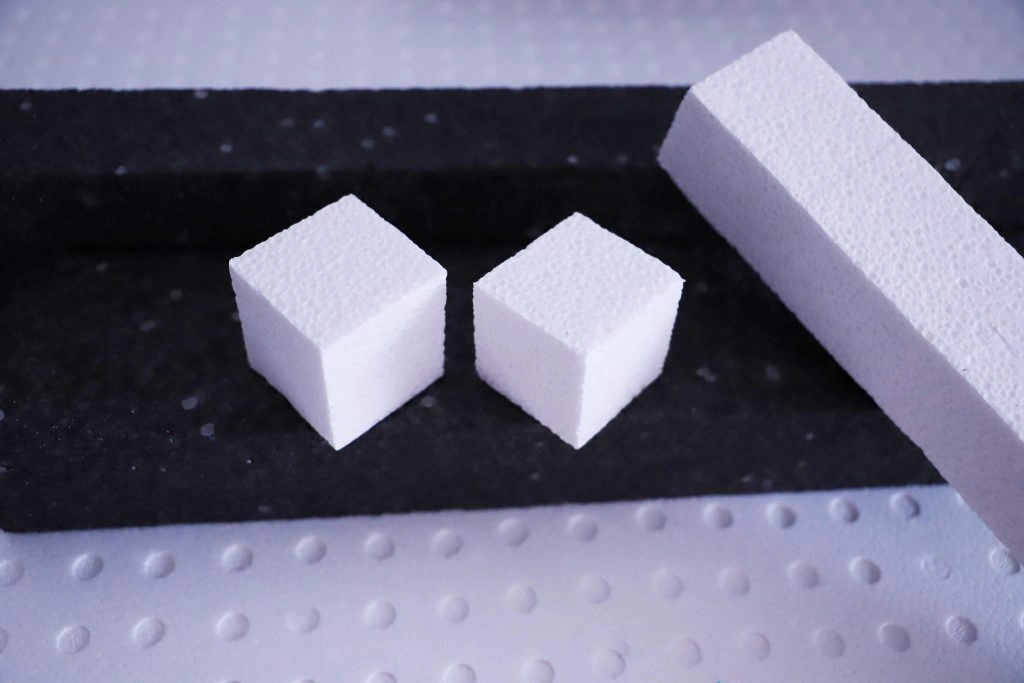Polystyrene blocks, created from Expanded Polystyrene (EPS), have become well-liked over old-style building items like concrete or bricks. They give special perks that attract workers on houses or shops. These light, foam-type blocks fit jobs that want better energy keeping and quicker build times. Knowing their good points and bad points helps workers pick smartly for build tasks.

Advantages of Polystyrene Blocks for Construction
Polystyrene blocks bring lots of plus sides. They fix many problems that workers and house owners face now.
Excellent Heat Keeping
Polystyrene blocks hold buildings warm in cold months and cool in hot months. They own a high R-value. This means they fight heat movement well. It cuts bills for warming and cooling. For example, HUASHENG’s S-33 shows a heat passing score under 0.033W/M.K. But normal EPS sits at 0.039W/M.K. So, S-33 keeps heat over 20% better. Thus, buildings need less power. This helps green aims. And it saves cash for owners in the long run. Homes that save energy also feel nicer all year.
Light and Simple to Move
These blocks weigh much less than concrete or bricks. This makes them easy to lift and put in place. Since they are light, they press less on a building’s base. As a result, workers can pick cheaper base plans. Also, lighter blocks need fewer big tools. This lowers moving costs. And it saves money while building.
Fast Build Steps
Polystyrene blocks come in big sizes. And they are simple to cut. This hurries up building a lot. Their quick foam making and short dry time help jobs end sooner. The shape cycle is fast too. So, workers use less help. And they finish tasks quicker. This saves time and cash. It makes jobs run smoother.
Strong Against Water and Mold
The blocks have a shut-cell setup. This stops water from getting in. It blocks mold that often grows on other stuff. Less mold makes healthier inside areas for kids or staff. It also cuts fix costs later. For instance, wet lower rooms happen less with these blocks. This keeps buildings in fine shape.
Good Noise Stopping
Polystyrene blocks cut down sound well. This works great for flats or work places where quiet matters. They lower heat passing in keep boards. This boosts both warmth and sound keeping. As a result, outside sounds like cars or wind stay away. This builds calm and snug inside spots for living or jobs.
Disadvantages of Polystyrene Blocks for Construction
Even with their strong points, polystyrene blocks have limits. Workers must think about these with care when setting up jobs.
Fire Dangers Without Right Care
Normal EPS lights up fast unless mixed with fire-stop additives. This brings safety fears. For example, HUASHENG’s F-flame retardant grade must not mix with untreated EPS. Mixing cuts fire fight power. Workers need to follow fire safe rules. Like Europe’s B1 mark for low burn. HUASHENG’s FSH-European standard grade hits this mark. To keep safe, workers should pick treated items. And put them in right.
Nature Worries
Polystyrene blocks do not break down by nature. This causes long waste problems if not reused. Their making uses oil. This lets out carbon smoke. Reusing EPS can happen. But it needs special spots and power. This bothers workers who like green items. HUASHENG’s Environmental protection grade, like FHE-N, uses safer mix-ins where bad stuff like HBCD is stopped. Still, green keeping stays hard for some jobs.
Weaker Build Than Old Items
Polystyrene blocks are not as tough as concrete or bricks. Their push strength sits about 10-60 kPa. But concrete reaches 20-40 MPa. They can’t hold big weights by themselves. Workers must add helps. Like steel or concrete in Insulated Concrete Forms (ICFs). This needs more plans and stuff. For instance, they don’t fit tall building walls without extra strength. This can make plans trickier.
Harm from Bugs and Sun
Without cover, bugs like termites or mice can bite through these blocks. Also, sun rays break down open surfaces in months. This turns them crisp and weak. Workers need to use sun-fight paints or covers. HUASHENG’s Carbon black grade, like FGE, fights sun better. This keeps blocks strong in open areas. Like outside walls.

Common Uses in the Building World
Polystyrene blocks are bendy. They fit many build jobs. Each uses their special traits.
Insulated Concrete Forms (ICFs) Systems
Polystyrene blocks often serve as shapes for poured concrete walls. They mix keep warmth with strength in one way. High-thick blocks (18KG/m³ or more) suit these tasks. They give warmth and hold for tough builds. For example, ICFs are liked for power-save homes or shop buildings. Because they save power and last long.
Roof and Floor Keeping
These blocks go under floors or roofs to boost power saving. HUASHENG’s S-33 series fits outside wall keep. They work great for power-save buildings. They guard the whole building from heat loss. This holds inside spots comfy. And it cuts power bills.
Bendy Inside Walls
Polystyrene blocks suit walls inside that don’t hold weight. They are easy to form and set. This gives workers more plan choices. For example, they can make special room sets. While keeping warmth perks. These walls show up often in work spots or flats for better ease.
HUASHENG: Trusted Supplier of REPS Products for Construction Needs
Good suppliers like HUASHENG make sure top quality and work for polystyrene block jobs. They give items fit to workers’ wants.
Variety of Product Grades for Different Needs
HUASHENG offers many grades to match different build tasks:
- Common grade: Has P-extra light stuff, B-Rapid prototyping grade, and E-standard stuff. These fit well for usual keep in daily jobs. Like home keep.
- Flame retardant grade: Has F-flame retardant, FB-light flame retardant, FS-flame retardant, and FSH-European standard flame retardant. These keep fire safe for homes, work spots, or plants.
- Graphite grade: Has FGE-Graphite polystyrene (suspension method), S-33 Graphite polystyrene (extrusion method), and S-32 Graphite polystyrene (extrusion method). These give better heat fight for top keep.
- Environmental protection grade: Has FHE-N-HBCD flame retardant and FGH-N-HBCD graphite flame retardant (suspension method). These use safer mix-ins in areas that stop bad stuff. This cuts nature harm.
- Carbon black grade: Has low heat passing carbon polystyrene FGE and black polystyrene FGE (suspension method). These fight sun rays. And they last longer in open spots.
- Customized grade: HUASHENG makes special fixes based on job wants. This helps workers meet odd issues. Like special keep or fire safe needs.

Conclusion
Polystyrene blocks give great heat and sound keep, light weight, and quick set up. They fit perfect for power-save jobs. Like Insulated Concrete Forms and inside walls. But their fire dangers, nature effects, and weaker build need smart care. With right care and top items from HUASHENG, workers can balance these good and bad sides. This turns polystyrene blocks into a useful pick for new build. By picking right grades and following best ways, workers can make smooth, safe, and comfy buildings.
Frequently Asked Questions (FAQs)
Q1: Are polystyrene blocks safe for homes?
A: Yes, they stay safe when mixed with fire-stop additives. And set right. HUASHENG’s FSH grade meets Europe’s B1 fire safe mark for low burn. This makes them fit for homes when built and used well.
Q2: Can polystyrene blocks be reused after a building comes down?
A: Yes, they can go to special spots that handle EPS trash. Reused stuff can turn into new build items. But reusing needs local spots. Blocks must stay apart from other stuff for good reusing.
Q3: How do polystyrene blocks deal with bad weather?
A: They keep warmth well in hot or cold places. But they need cover coats. Like sun-fight paints to stop sun harm. HUASHENG’s S-32 series fits passive houses and high-mark power-save buildings. With good set up, they work steady in hard weather.






